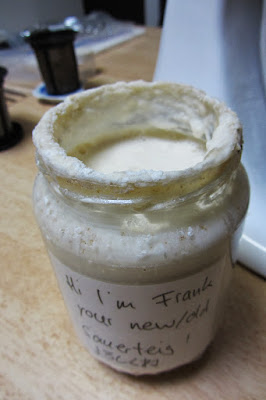Today’s coffee: Costa Rica, Ethiopia (Yay, back at Tokumitsu again!)
The garden has been going crazy lately—I’ve got more produce than I know what to do with. The weeding is pretty much under control, but I really underestimated the amount of time it takes to harvest and process everything… but since “waste not, want not” is my missionary-budget-motto, I use everything I possibly can.
That being said, it’s really helpful when people come eat our food at our house… provided they don’t bring too much food with them. It’s customary in Japan to bring something to share when you eat at someone’s house. Last Saturday, we had several friends over for Baroque music sightreading (3 gambas and 2 recorders!) and barbeque. They brought drinks, watermelon, snacks, and dessert—we didn’t actually eat the watermelon, and 11 or the 12 mini ice creams also didn’t get eaten, since the dessert I made was very filling. The weather was beautiful; it’s been a long time since I sat outside and had a leisurely supper with friends.
The ice creams and watermelon ended up being very helpful since I bit my tongue eating breakfast on Monday and couldn’t eat properly for about 3 days. Ouch. Thankful also for our immersion blender and the lovely fresh tomatoes that we made into soup. And I’m thankful for my now fully functional tongue. I underestimated its usefulness…
With the garden flourishing and friends coming over to eat with some frequency, I continue to think about showing hospitality, in particular to my Japanese friends. I intend to return to this topic many times, but I’ll start with a few thoughts about hospitality in general.
First, it’s not about me.
As I wrote last week, hospitality means making guests feel comfortable. It’s not about me showing off my cooking skills.
Style of hospitality and food should depend on the guest. For example, which guests are adventurous eaters, and which ones aren’t? Which guests will appreciate and enjoy eating off of our Royal Copenhagen dishes, and which will be worried about breaking them? Will the guest feel more at home if we leave the house in a “lived-in” state? If I’m having my baroque music friends over—most of them have been overseas many times—anything goes as far as food is concerned, but probably keeping the atmosphere relaxed is good. If I’m inviting guests my parents’ age and older, I will want to make sure all the preparations are done before they arrive, and I will want to be careful what sorts of food to prepare. The purpose of careful preparation and choice of food is to make guests feel at home in our house.
What kind of food might be appropriate? Since
the taste-test lunch, I’ve been thinking a lot about the differences between Japanese and Western cooking, and how to make the most of Japanese cooking techniques and philosophy when preparing Western food.
In US home cooking, we often have one-pot meals. These are convenient and easy to prepare and clean up. They tend to have a lot of ingredients, providing a balanced meal in a single dish. The blended flavours are highly valued. However, in Japanese cooking, one-pot meals are rare. Usually a meal with consist of rice (御飯—gohan, the word for cooked rice, literally means “meal”), one or more meat and vegetable “side dishes,” soup, and pickles. Each dish has only a few ingredients; when I first started cooking from Japanese recipes, they seemed overly simple, and I was inclined to make a lot of additions. That wasn’t necessarily a good choice; authentic Japanese cooking allows each ingredient to be appreciated on its own. Using in-season, fresh ingredients and cooking techniques that minimize loss of flavour and colour are very important.
In Western cooking, we use a wide variety of herbs and spices to flavour our foods. Growing up in the US, being the melting pot that it is, I was exposed to foods from all over the world. I learned to cook from my mom, whose cooking is influenced by her Midwestern parents; my dad, who excels at experimental and fusion soups and stews; our Swedish-descent neighbours; our German exchange student; and my Taiwanese college roommate. In my cooking, I tend to use a wide variety of flavours from each of these cuisines and others as well. In Japanese cooking, flavouring ingredients typically consist of what I call the “5 s’s” or “the usual suspects”: shoyu (soy sauce), saké, mirin (sweet saké), shio (salt), and satou (sugar). With a vast number of interesting techniques and wonderful seasonal produce, there are endless possibilities even within this seemingly narrow flavour profile.
When Western recipes are adapted to Japanese taste, the number of ingredients is vastly reduced… and we call it 洋食 (youshoku—western food). I compared 2 recipes for minestrone soup: the recipe from a Canadian cookbook had 24 ingredients, whereas the one from a Japanese magazine had 12 ingredients. I remember ordering Spaghetti Carbonara once at an Italian restaurant in Japan; I was surprised when it came with a poached egg on top (rather than the egg being incorporated into the cream sauce), and no pepper. As I mentioned before, the ingredients are meant to be enjoyed individually.
When my friends at church explained what they thought needed to be changed from my proposed lunch menu, they specifically suggested that the herb flavour was too strong for elderly guests. At first I was surprised; the Japanese herb, shiso, also has a strong flavour (and I thank God every time I eat it). Then I recalled the conversation in the kitchen while cutting up the mint: “Ah, reminds me of toothpaste,” said one of the helpers. Mint=toothpaste or tea, not a topping for a savoury dish. I further recalled the aforementioned Taiwanese college roommate turning up her nose at rice pudding: rice is savoury, not sweet, she explained. Specific flavours (cilantro, etc.) may not suit some people’s tastes, but certain combinations of flavours are also off-putting to some people. Please do leave comments if you have ideas about combinations and specific flavours to try or to avoid!
I have a lot of further study to do in this area; I think for me, learning to adapt Western recipes according to Japanese taste might be more difficult than learning to cook Japanese food. I think the way forward is to cook Western recipes from Japanese cookbooks, and to continue to experiment with my own recipes… and invite trusted friends over to be taste-testers. Any volunteers?













































